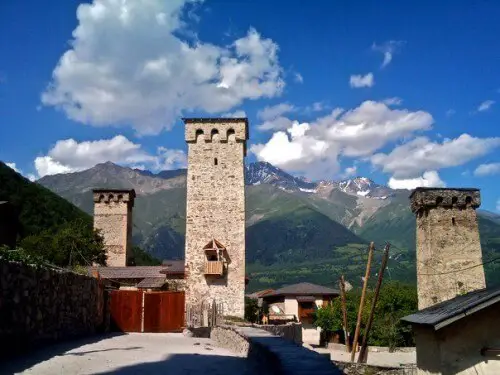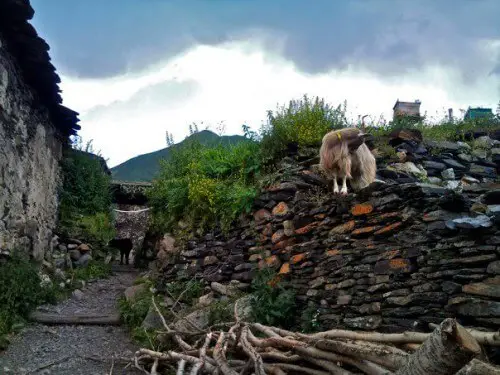The peaks of the Caucasus Mountains dwarf the crumbling defensive towers that are doing their best to reach up to the sky. High above the rest of Europe, for those who still include Georgia as its final frontier, the village of Ushguli is the continent’s highest continually inhabited settlement.
Ushguli is also unusual in that it’s not a singular village, but rather four small communities clustered together in a remote part of northern Georgia. This region of Svaneti is a land wrapped in myth. It was once the supposed home of the Golden Fleece, where sheepskin hides were used in panning for gold in the mountain rivers, and Svaneti also made up the northern fringes of the ancient kingdom of Colchis. In more recent history, Svaneti was known for its bandits, Medieval defensive towers and local tribes with their own culture and the Svan language.
Since the new road opened, connecting the rest of Georgia to Mestia, the main town in Svaneti, the region has started to modernise at a drastic rate. Mestia has already embarked on its aggressive mission to become the Swiss resort of the Caucasus, and while the old part of the town retains its unique character dotted with signature Svan towers, the rest of the town has been transformed into a chic European style ski resort.
Ushguli on the otherhand provides an old world contrast, since it is protected by its position deep the mountains and is at the end of a bad road only accessible by a vehicle with a four wheel drive. However, it is only a matter of time till the modern world catches up with it.
Young men still ride through Ushguli’s streets, galloping on horseback besides free-range livestock, ranging from pigs to goats, splashing through the muddy paths in a world that feels like it hasn’t changed in centuries. The only sign of the outside, modern world are the electricity pilons hanging losely between the houses.
At first the dilapidation is a bit of a shock. Parts of the village are abandoned, with towers that have partly collapsed or emptied buildings, scattered in clusters between the craggy mountains and rolling green hills and wild woodlands. The first communities we passed on the road from Mestia, Murqmeli and Chazhashi, are the most run down, but crossing the river, headed up by a glacier that’s 8km away, the livelier hamlets of Chvibiani and Zhibiani are where we found the core of Ushguli’s life. There are 70 families in Ushguli and one small school in Ushguli. Despite its location of being 2200m above sea level, and being in a region that can often get cut off from the world in the winter, it is a community that is continually inhabited.
The tourist infrastructure is minimal, with a small café in Chvibiani serving a hearty Svan meat pie known as Kubdari and pitchers of beer. There are some guesthouses and homestays in the busier part of the village, but it’s a complete contrast to the Alpine resort back in Mestia.
Ushguli’s lone café-cum-bar still attracts its fair share of characters, from the Iranian and Bulgarian hippie duo travelling round the world looking to spread love in remote corners of the world to the two young Israelis who had just got out of their military service, not to mention the frustrated Englishman heading through the mountains on a banger rally from Budapest to Yerevan.
I separated from our group to explore the quieter parts of the village. Although, the 35ºC weather quickly turned into a cold shower, and I found myself sheltering in the ruins in Chazhashi, rather concerned about the thunder and lightening that shook the loose stones in the tower above me. Fortunately the rain didn’t last, and I trudged though the muddy path down to Murqmeli on the outskirts of the village. However, this hamlet was the least populated and almost entirely ruined. It resembled a ghost town, but there was still a family or two living among the ruins. Children kicked a ball about in an open yard that framed the site of a house that once stood there.
Going back to Svaneti’s main town reminded me that Ushguli’s remote and unique life and culture was at risk from succumbing to the modern world. Would it also become a part of the new Georgian Switzerland or somehow retain its own identity while co-existing with our century?








Very well done
Wonderful! It looks like a fairy tale! I fly to Georgia in late May and this is the place I want to visit, however, I do not know how to get there. Marshrutka or taxi?
Hi Angel, I actually chartered a marshrutka with a few others we travelled up with from Zugdidi, but that was back in 2012, so I can imagine that things have changed quite a bit with the new road that’s recently been built (I’m going back again this June, so will be interesting to compare). There was a public marshrutka, but it didn’t run very frequently at the time so you’d need to stay the night, but I think it’s probably easier to get there now. Good luck and enjoy the trip! Georgia is amazing.
Since 2012 it’s pretty much the same, it hasn’t changed yet, but soon, once the road-building is finished and Ushguli is not cut from the World that much it will change… I hope for devotion of locals for their village, that they will manage to maintain the “Wild” or “Untouched” part of the life there as it is… Honestly, that’s the most mesmerizing places at least in Georgia. Well done and beautifully written 🙂
Hi Keti, thanks for your kind comments 🙂 I returned to Ushguli last week, and it was interesting (if not a relief!) to see that not much had changed. There was one more cafe in place, but the spirit of the place was unchanged. Also the road from Mestia has not gone much further than when I went in 2012, so I think Ushguli is safe for the moment from change. I liked Mestia more this time. I think seeing everything under construction last time ruined it a bit for me, this time I felt it was more complete. It was great to be back in the Caucasus even for just a short time!
I taught English in Usdhguli. So nice to read your article.
I hope Ushguli will remain as it is.